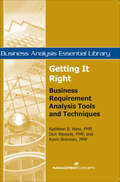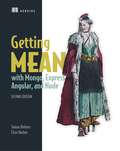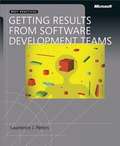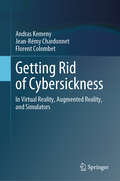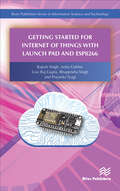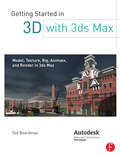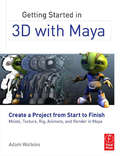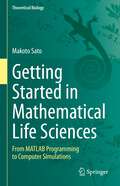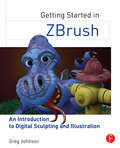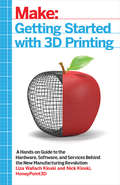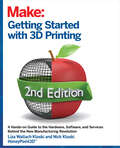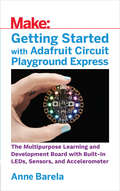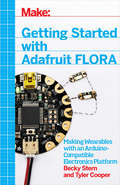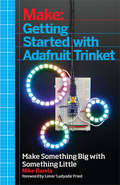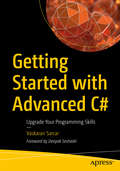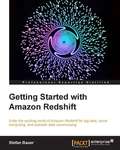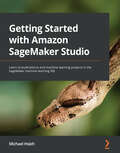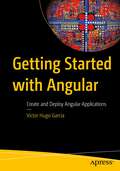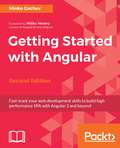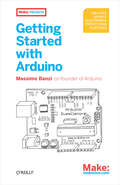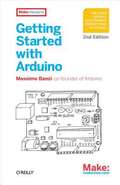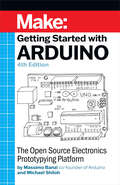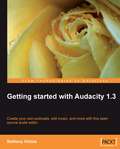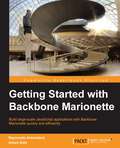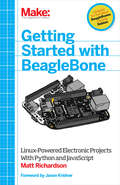- Table View
- List View
Getting It Right: Business Requirement Analysis Tools and Techniques
by Kevin Brennan Don Wessels Kathleen B HassVolume of the Business Analysis Essential Library SeriesGetting It Right: Business Requirement Analysis Tools and Techniques, presents principles and practices for effective requirements analysis and specification, and a broad overview of the requirements analysis and specification processes. This critical reference is designed to help the business analyst decide which requirement artifacts should be produced to adequately analyze requirements. Examine the complete spectrum of business requirement analysis from preparation through documentation. Learn the steps in the analysis and specification process, as well as, how to choose the right requirements analysis techniques for your project.
Getting MEAN with Mongo, Express, Angular, and Node
by Simon Holmes clive harberSummaryGetting MEAN, Second Edition teaches you how to develop full-stack web applications using the MEAN stack. This edition was completely revised and updated to cover MongoDB 4, Express 4, Angular 7, Node 11, and the latest mainstream release of JavaScript ES2015.Purchase of the print book includes a free eBook in PDF, Kindle, and ePub formats from Manning Publications.About the TechnologyJuggling languages mid-application can radically slow down a full-stack web project. The MEAN stack—MongoDB, Express, Angular, and Node—uses JavaScript end to end, maximizing developer productivity and minimizing context switching. And you'll love the results! MEAN apps are fast, powerful, and beautiful.About the BookGetting MEAN, Second Edition teaches you how to develop full-stack web applications using the MEAN stack. Practical from the very beginning, the book helps you create a static site in Express and Node. Expanding on that solid foundation, you'll integrate a MongoDB database, build an API, and add an authentication system. Along the way, you'll get countless pro tips for building dynamic and responsive data-driven web applications! What's insideMongoDB 4, Express 4, Angular 7, and Node.js 11MEAN stack architectureMobile-ready web appsBest practices for efficiency and reusabilityAbout the ReaderReaders should be comfortable with standard web application designs and ES2015-style JavaScript.About the AuthorSimon Holmes and Clive Harber are full-stack developers with decades of experience in JavaScript and other leading-edge web technologies.Table of ContentsPART 1 - SETTING THE BASELINEIntroducing full-stack developmentDesigning a MEAN stack architecturePART 2 - BUILDING A NODE WEB APPLICATIONCreating and setting up a MEAN projectBuilding a static site with Node and ExpressBuilding a data model with MongoDB and MongooseWriting a REST API: Exposing the MongoDB database to the applicationConsuming a REST API: Using an API from inside ExpressPART 3 - ADDING A DYNAMIC FRONT END WITH ANGULARCreating an Angular application with TypeScriptBuilding a single-page application with Angular: FoundationsBuilding a single-page application with Angular: The next levelPART 4 - MANAGING AUTHENTICATION AND USER SESSIONSAuthenticating users, managing sessions, and securing APIsUsing an authentication API in Angular applications
Getting Results from Software Development Teams
by Lawrence J. PetersLearn best practices for software development project management--and lead your teams and projects to success. Dr. Lawrence Peters is an industry-recognized expert with decades of experience conducting research and leading real-world software projects. Beyond getting the best developers, equipment, budget, and timeline possible--Peters concludes that no factor is more critical to project success than the manager's role. Drawing on proven practices from allied industries such as business, psychology, accounting, and law, he describes a broader project-management methodology--with principles that software managers can readily adapt to help increase their own effectiveness and the productivity of their teams. Unlike other books on the topic, this book focuses squarely on the manager--and shows how to get results without adopting philosophies from Genghis Khan or Machiavelli. (There is mention of Godzilla, however.) Packed with real-world examples and pragmatic advice, this book shows any software development manager--new or experienced--how to lead teams in delivering the right results for their business.
Getting Rid of Cybersickness: In Virtual Reality, Augmented Reality, and Simulators
by Andras Kemeny Jean-Rémy Chardonnet Florent ColombetThis book provides a concise overview of VR systems and their cybersickness effects, giving a description of possible reasons and existing solutions to reduce or avoid them. Moreover, the book explores the impact that understanding how efficiently our brains are producing a coherent and rich representation of the perceived outside world would have on helping VR technics to be more efficient and friendly to use.Getting Rid of Cybersickness will help readers to understand the underlying technics and social stakes involved, from engineering design to autonomous vehicle motion sickness to video games, with the hope of providing an insight of VR sickness induced by the emerging immersive technologies. This book will therefore be of interest to academics, researchers and designers within the field of VR, as well as industrial users of VR and driving simulators.
Getting Started for Internet of Things with Launch Pad and ESP8266
by Rajesh Singh Anita Gehlot Lovi Raj Gupta Bhupendra Singh Priyanka TyagiGetting Started for Internet of Things with Launch Pad and ESP8266 provides a platform to get started with the Ti launch pad and IoT modules for Internet of Things applications. The book provides the basic knowledge of Ti launch Pad and ESP8266 based customized modules with their interfacing, along with the programming.The book discusses the application of Internet of Things in different areas. Several examples for rapid prototyping are included, this to make the readers understand the concept of IoT.The book comprises of twenty-seven chapters, which are divided into four sections and which focus on the design of various independent prototypes. Section-A gives a brief introduction to Ti launch pad (MSP430) and Internet of Things platforms like GPRS, NodeMCU and NuttyFi (ESP8266 customized board), and it shows steps to program these boards. Examples on how to interface these boards with display units, analog sensors, digital sensors and actuators are also included, this to make reader comfortable with the platforms. Section-B discusses the communication modes to relay the data like serial out, PWM and I2C. Section-C explores the IoT data loggers and shows certain steps to design and interact with the servers. Section-D includes few IoT based case studies in various fields. This book is based on the practical experience of the authors while undergoing projects with students and partners from various industries.
Getting Started in 3D with 3ds Max: Model, Texture, Rig, Animate, and Render in 3ds Max
by Ted BoardmanLearning a 3D visualization software is a daunting task under any circumstances and while it may be easy to find online tutorials that tell you what to do to perform certain tasks you'll seldom learn "why" you are performing the steps. This book approaches training from a top-down perspective way you will first learn important concepts of 3D visualization and functionality of 3ds Max before moving into the finer detail of the command structure. By learning how things work and why you might choose one method over another the book will not only teach you where the buttons are, but more importantly how to think about the holistic process of 3D design so that you can then apply the lessons to your own needs. The goal of the learning presented here is to familiarize the new user of 3ds Max with a typical workflow from a production environment from planning to modeling, materials, and lighting, and then applying special effects and compositing techniques for a finished product.
Getting Started in 3D with Maya: Create a Project from Start to Finish—Model, Texture, Rig, Animate, and Render in Maya
by Adam WatkinsDeliver professional-level 3D content in no time with this comprehensive guide to 3D animation with Maya. With over 12 years of training experience, plus several award winning students under his belt, author Adam Watkins is the ideal mentor to get you up to speed with 3D in Maya. Using a structured and pragmatic approach Getting Started in 3D with Maya begins with basic theory of fundamental techniques, then builds on this knowledge using practical examples and projects to put your new skills to the test. Prepared so that you can learn in an organic fashion, each chapter builds on the knowledge gained in the previous chapter, showing you all the essentials of 3D in Maya, from modeling and UV layout, to texture creation, rigging animating and rendering. As you go from project to project you'll develop a strong arsenal of skills that combined will form a complete end to end process to creating complete projects in Maya. The accompanying website provides all the tools you need to develop your skills. Project files to accompany the practical examples used throughout the text, so you can work along with the examples. Additional textures and models will give you all the resources you need to start making your own projects in no time at all.
Getting Started in Mathematical Life Sciences: From MATLAB Programming to Computer Simulations (Theoretical Biology)
by Makoto SatoThis book helps the reader make use of the mathematical models of biological phenomena starting from the basics of programming and computer simulation. Computer simulations based on a mathematical model enable us to find a novel biological mechanism and predict an unknown biological phenomenon. Mathematical biology could further expand the progress of modern life sciences. Although many biologists are interested in mathematical biology, they do not have experience in mathematics and computer science. An educational course that combines biology, mathematics, and computer science is very rare to date. Published books for mathematical biology usually explain the theories of established mathematical models, but they do not provide a practical explanation for how to solve the differential equations included in the models, or to establish such a model that fits with a phenomenon of interest. MATLAB is an ideal programming platform for the beginners of computer science. This book starts from the very basics about how to write a programming code for MATLAB (or Octave), explains how to solve ordinary and partial differential equations, and how to apply mathematical models to various biological phenomena such as diabetes, infectious diseases, and heartbeats. Some of them are original models, newly developed for this book. Because MATLAB codes are embedded and explained throughout the book, it will be easy to catch up with the text. In the final chapter, the book focuses on the mathematical model of the proneural wave, a phenomenon that guarantees the sequential differentiation of neurons in the brain. This model was published as a paper from the author’s lab (Sato et al., PNAS 113, E5153, 2016), and was intensively explained in the book chapter “Notch Signaling in Embryology and Cancer”, published by Springer in 2020. This book provides the reader who has a biological background with invaluable opportunities to learn and practice mathematical biology.
Getting Started in ZBrush: An Introduction to Digital Sculpting and Illustration
by Greg JohnsonGetting Started in ZBrush is a gentle introduction to ZBrush, today’s premier digital sculpting program. Beginning with the fundamentals of digital sculpting as well as a thorough introduction to the user interface, Getting Started in ZBrush will have you creating a variety of professional-level 3D models in no-time. More than just another button-pushing manual, this comprehensive guide is packed with start-to-finish projects that ease you into the workflow of the program, while at the same time providing tips and tricks that will allow you to achieve certain tasks much more quickly. After progressing through the tutorials, you will be shown how to customize brushes, materials, scripts, and the interface so that you can utilize these tools to their full advantage. Special consideration is given to ZBrush’s integration plug-ins with Maya and 3ds Max, allowing you to properly import and export your models in all programs. Texturing, painting, mapping, decimation, baking, and topology are also fully covered so your Zbrush creations can come to life without sacrificing that high-resolution look. Ease your way into this complex subject with this straight-forward approach to ZBrush Perfect your technique with step-by-step tutorials that allow you to create high res models from start to finish. Expand your knowledge by visiting the companion website, which features video demonstrations, project files, texture and model files, scripts, customized menus, brushes, and additional resources.
Getting Started with 3D Printing: A Hands-on Guide to the Hardware, Software, and Services Behind the New Manufacturing Revolution
by Liza Wallach Kloski Nick KloskiMake: Getting Started with 3D Printing is a practical, informative, and inspiring book that guides readers step-by-step through understanding how this new technology will empower them to take full advantage of all it has to offer. The book includes fundamental topics such as a short history of 3D printing, the best hardware and software choices for consumers, hands-on tutorial exercises the reader can practice for free at home, and how to apply 3D printing in the readers' life and profession. For every maker or would-be maker who is interested, or is confused, or who wants to get started in 3D printing today, this book offers methodical information that can be read, digested, and put into practice immediately!
Getting Started with 3D Printing
by Liza Wallach Kloski Nick KloskiThe book is written in a casual, conversational style. It is easily accessible to those who have no prior knowledge in 3D printing, yet the book's message is solidly practical, technically accurate, and consumer-relevant. The chapters include contemporary, real-life learning exercises and insights for how to buy, use and maintain 3D printers. It also covers free 3D modeling software, as well as 3D printing services for those who don't want to immediately invest in the purchase of a 3D printer. Particular focus is placed on free and paid resources, the various choices available in 3D printing, and tutorials and troubleshooting guides.
Getting Started with Adafruit Circuit Playground Express: The Multipurpose Learning and Development Board with Built-In LEDs, Sensors, and Accelerometer.
by Mike BarelaFrom Adafruit Industries, a leader in products to Makers, designers, students young and old, comes the Circuit Playground Express. Connect it to your PC/Mac/Linux device, and you can be programming interactive projects in minutes. You have a choice of programming environments to choose from: Python, the Microsoft MakeCode graphical building block environment, C/C++ via the Arduino development environment and JavaScript.ment their ideas.
Getting Started with Adafruit FLORA
by Tyler Cooper Becky SternThis book introduces readers to building wearable electronics projects using Adafruit's tiny FLORA board: at 4.4 grams, and only 1.75 inches in diameter, and featuring Arduino compatibility, it's the most beginner-friendly way to create wearable projects. This book shows you how to plan your wearable circuits, sew with electronics, and write programs that run on the FLORA to control the electronics. The FLORA family includes an assortment of sensors, as well as RGB LEDs that let you add lighting to your wearable projects.
Getting Started with Adafruit Trinket
by Mike BarelaArduino's ubiquity and simplicity has led to a gigantic surge in the use of microcontrollers to build programmable electronics project. Despite the low cost of Arduino, you're still committing about $30 worth of hardware every time you build a project that has an Arduino inside. This is where Adafruit's Trinket comes in. Arduino-compatible, one-third the price, and low-power, the Trinket lets you make inexpensive and powerful programmable electronic projects. Written by one of the authors of Adafruit's Trinket documentation, Getting Started with Trinket gets you up and running quickly with this board, and gives you some great projects to inspire your own creations.
Getting Started with Advanced C#: Upgrade Your Programming Skills
by Vaskaran SarcarUnderstand and work with the most important features of advanced C# in different programming environments. This book teaches you the fundamental features of advanced C# and how to incorporate them in different programming techniques using Visual Studio 2019.The book is divided into two parts. Part I covers the fundamentals and essentials of advanced programming in C#. You will be introduced to delegates and events and then move on to lambda expressions. Part II teaches you how to implement these features in different programming techniques, starting with generic programming. After that, you will learn about thread programming and asynchronous programming, to benefit from a multi-threaded environment. Finally, you will learn database programming using ADO.NET to connect to a MySQL database and you will know how to exercise SQL statements and stored procedures through your C# applications.What You Will Learn Use delegates, events, and lambda expressions in advanced programmingMake your application flexible by utilizing genericsCreate a fast application with multi-threading and asynchronous programmingWork in Visual Studio Community Edition, which is the most common IDE for using C#Understand alternative implementations along with their pros and cons Who This Book Is ForDevelopers and programmers who are already working in C#
Getting Started With Amazon Redshift
by Stefan BauerGetting Started With Amazon Redshift is a step-by-step, practical guide to the world of Redshift. Learn to load, manage, and query data on Redshift.This book is for CIOs, enterprise architects, developers, and anyone else who needs to get familiar with RedShift. The CIO will gain an understanding of what their technical staff is working on; the technical implementation personnel will get an in-depth view of the technology, and what it will take to implement their own solutions.
Getting Started with Amazon SageMaker Studio: Learn to build end-to-end machine learning projects in the SageMaker machine learning IDE
by Michael HsiehBuild production-grade machine learning models with Amazon SageMaker Studio, the first integrated development environment in the cloud, using real-life machine learning examples and codeKey FeaturesUnderstand the ML lifecycle in the cloud and its development on Amazon SageMaker StudioLearn to apply SageMaker features in SageMaker Studio for ML use casesScale and operationalize the ML lifecycle effectively using SageMaker StudioBook DescriptionAmazon SageMaker Studio is the first integrated development environment (IDE) for machine learning (ML) and is designed to integrate ML workflows: data preparation, feature engineering, statistical bias detection, automated machine learning (AutoML), training, hosting, ML explainability, monitoring, and MLOps in one environment. In this book, you'll start by exploring the features available in Amazon SageMaker Studio to analyze data, develop ML models, and productionize models to meet your goals. As you progress, you will learn how these features work together to address common challenges when building ML models in production. After that, you'll understand how to effectively scale and operationalize the ML life cycle using SageMaker Studio. By the end of this book, you'll have learned ML best practices regarding Amazon SageMaker Studio, as well as being able to improve productivity in the ML development life cycle and build and deploy models easily for your ML use cases.What you will learnExplore the ML development life cycle in the cloudUnderstand SageMaker Studio features and the user interfaceBuild a dataset with clicks and host a feature store for MLTrain ML models with ease and scaleCreate ML models and solutions with little codeHost ML models in the cloud with optimal cloud resourcesEnsure optimal model performance with model monitoringApply governance and operational excellence to ML projectsWho this book is forThis book is for data scientists and machine learning engineers who are looking to become well-versed with Amazon SageMaker Studio and gain hands-on machine learning experience to handle every step in the ML lifecycle, including building data as well as training and hosting models. Although basic knowledge of machine learning and data science is necessary, no previous knowledge of SageMaker Studio and cloud experience is required.
Getting Started with Angular: Create and Deploy Angular Applications
by Victor Hugo GarciaImmerse yourself in the architecture of an Angular application, starting with an introduction to TypeScript and ES6, and progressing to modules and components used to build complex applications. This book presents a hands-on approach to becoming a proficient Angular developer by building three complete applications.You’ll start with an overview of the Angular framework where TypeScript and ES6 are introduced. Next you’ll see how to build an application (RestApp) using the in-memory module to mock an API that communicates with a rest API performing crud operations. This is followed by an application (AuthApp) that uses a third party service to provide authentication and authorization capabilities to handle registrations. You’ll then build an application (BlogApp) that communicates with a MongoDB database in six parts.Part 1 covers MongoDB, how to install bootstrap, login service, and adding the logic of the form. Part 2 covers how to start the project on the server, create the database and AuthService, and save the user in the session. In Parts 3 and 4 you will learn to create the post collection, post component, and sharpen details. In Parts 5 and 6 you will study adding, editing, and deleting posts with testing. By the end of the book you'll have the necessary knowledge to write and execute automated tests on your applications, and deploy them to a server. What You’ll Learn Divide the logic of an application into componentsCommunicate with an APIRelease the power of the observables to solve asynchronous programming problems Include Bootstrap so that your application looks great on different devices Who This Book Is For Web developers with basic knowledge of JavaScript, HTML, and CSS.
Getting Started with Angular - Second Edition
by Minko GechevFast-track your web development skills to build high performance SPA with Angular 2 and beyond About This Book • Up to date with the latest API changes introduced by Angular 2 and 4 • Get familiar with the improvements to directives, change detection, dependency injection, router, and more • Understand Angular's new component-based architecture • Start using TypeScript to supercharge your Angular applications Who This Book Is For Do you want to jump in at the deep end of Angular? Or perhaps you're interested assessing the changes to AngularJS before moving over? If so, then "Getting Started with Angular" is the book for you. To get the most out of the book, you'll need to be familiar with AngularJS 1.x, and have a good understanding of JavaScript. What You Will Learn • Understand the changes made from AngularJS with side-by-side code samples to help demystify the Angular learning curve • Start working with Angular's new method of implementing directives • Use TypeScript to write modern, powerful Angular applications • Dig in to the change detection method, and other architectural changes to make sure you know what's going on under the hood of Angular • Get to work with the new router in Angular • Use the new features of Angular, including pipes, and the updated features such as forms, services, and dependency injection • Learn about the server-side rendering in Angular to keep your new applications SEO-friendly • Enhance your applications using Ahead-of-Time compilation and Web Workers In Detail I'm delighted to see this new update and hope it helps you build amazing things with Angular. - Misko Hevery, Creator of AngularJS and Angular Angular is the modern framework you need to build performant and robust web applications. This book is the quickest way to upgrade your AngularJS knowledge to the brave new world of Angular, and get grips with the framework. It starts with an overview putting the changes of the framework in context with version 1. After that, you will be taken on a TypeScript crash-course so you can take advantage of Angular in its native, statically-typed environment. You'll explore the new change detection mechanism in detail, how directives and components have changed, how you create applications with Angular, and much more. Next, you'll understand how to efficienly develop forms, use the router, implement communication with HTTP services, and transform data with custom pipes. Finally, we will take a look at the Angular's Ahead-of-Time compiler, angular-cli and other such tools that help us build professional applications. By the end of the book, you'll be ready to start building quick and efficient Angular applications compatible with v2 and v4, that take advantage of all the new features on offer. This book is up to date for the 2.4 release and is compatible with the 4.0 release as well. Style and approach Starting with a comparison between Angular versions, this book is filled with side-by-side code examples to help highlight the changes. Each chapter then looks at major changes to the framework and is filled with small examples and sample code to get you started.
Getting Started with Arduino: The Open Source Electronics Prototyping Platform (Make: Projects)
by Massimo BanziThis valuable little book offers a thorough introduction to the open-source electronics prototyping platform that's taking the design and hobbyist world by storm. Getting Started with Arduino gives you lots of ideas for Arduino projects and helps you get going on them right away. From getting organized to putting the final touches on your prototype, all the information you need is right in the book. Inside, you'll learn about:Interaction design and physical computingThe Arduino hardware and software development environmentBasics of electricity and electronicsPrototyping on a solderless breadboardDrawing a schematic diagramAnd more. With inexpensive hardware and open-source software components that you can download free, getting started with Arduino is a snap. To use the introductory examples in this book, all you need is a USB Arduino, USB A-B cable, and an LED.Join the tens of thousands of hobbyists who have discovered this incredible (and educational) platform. Written by the co-founder of the Arduino project, with illustrations by Elisa Canducci, Getting Started with Arduino gets you in on the fun! This 128-page book is a greatly expanded follow-up to the author's original short PDF that's available on the Arduino website.
Getting Started with Arduino
by Massimo BanziArduino is the open-source electronics prototyping platform that's taken the design and hobbyist world by storm. This thorough introduction, updated for Arduino 1.0, gives you lots of ideas for projects and helps you work with them right away. From getting organized to putting the final touches on your prototype, all the information you need is here! Inside, you'll learn about: Interaction design and physical computing The Arduino hardware and software development environment Basics of electricity and electronics Prototyping on a solderless breadboard Drawing a schematic diagram Getting started with Arduino is a snap. To use the introductory examples in this guide, all you need an Arduino Uno or earlier model, along with USB A-B cable and an LED. The easy-to-use Arduino development environment is free to download. Join hundreds of thousands of hobbyists who have discovered this incredible (and educational) platform. Written by the co-founder of the Arduino project, Getting Started with Arduino gets you in on all the fun!
Getting Started With Arduino
by Massimo Banzi Michael ShilohArduino is the open source electronics prototyping platform that has taken the Maker Movement by storm. This thorough introduction, updated for the latest Arduino release, helps you start prototyping right away. From obtaining the required components to putting the final touches on your project, all the information you need is here!Getting started with Arduino is a snap. To use the introductory examples in this guide, all you need is an Arduino Uno or Leonardo, along with a USB cable and an LED. The easy-to-use, free Arduino development environment runs on Mac, Windows, and Linux.In Getting Started with Arduino, you'll learn about:Interaction design and physical computingThe Arduino board and its software environmentBasics of electricity and electronicsPrototyping on a solderless breadboardDrawing a schematic diagramTalking to a computer--and the cloud--from ArduinoBuilding a custom plant-watering system
Getting started with Audacity 1.3
by Bethany HiitolaConversational and practical, this book is full of real life examples of where and how you would use the Audacity software. Not only does it give you task-based step-by-step instructions from installation to advanced audio editing techniques, it caters to the beginner to familiarize them with all the jargon, suggests recording equipment, it walks them through a simple sample project showing off everything Audacity can do. If you are new to audio recording and editing, and particularly using the Audacity software, this book is for you. It explains everything from common audio industry terms and software basics. Technical sound engineering details and jargon are omitted to keep the book friendly and easy to understand.
Getting Started with Backbone Marionette
by Arturo Soto Raymundo ArmendarizThis book is written with an easy-to-understand approach with the intention of giving small but concrete examples that will help you to quickly understand each component of Marionette. Follow along as we work together to build a practical application using Backbone Marionette. If you are a web application developer interested in using Backbone Marionette for a real-life project, then this book is for you. As a prerequisite, knowledge of JavaScript and a working knowledge of Backbone.js is required.
Getting Started with BeagleBone
by Matt RichardsonMany people think of Linux as a computer operating system, running on users' desktops and powering servers. But Linux can also be found inside many consumer electronics devices. Whether they're the brains of a cell phone, cable box, or exercise bike, embedded Linux systems blur the distinction between computer and device. Many makers love microcontroller platforms such as Arduino, but as the complexity increases in their projects, they need more power for applications, such as computer vision. The BeagleBone is an embedded Linux board for makers. It's got built-in networking, many inputs and outputs, and a fast processor to handle demanding tasks. This book introduces you to both the original BeagleBone and the new BeagleBone Black and gets you started with projects that take advantage of the board's processing power and its ability to interface with the outside world.
